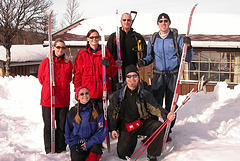 As the winter storms begin across the country, and skiers head for the slopes, we researched what kind of coverage skiers would most want with their travel insurance plans.
As the winter storms begin across the country, and skiers head for the slopes, we researched what kind of coverage skiers would most want with their travel insurance plans.
The first step to insuring your ski trip is to be sure that the coverage plan you choose allows skiing as a covered activity. Otherwise, you’ll need to add a hazardous sports waiver to your plan. Most plans allow for regular skiing, but ‘extreme skiing’ requires the purchase of additional sports coverage.
Trip Cancellations and Travel Delays
When you are traveling to ski country, there’s a high likelihood in some areas that a winter storm will affect your arriving on time. After all, all that snow doesn’t just fall in the ski slopes. Cancellations and delays due to weather have to be accompanied by a complete cessation of services for a minimum number of hours. So, if you are flying out of JFK and headed to Denver, if the weather shuts down the airports and causes your carrier to be grounded for that minimum number of hours, then you’ll have a covered reason to cancel your trip or reimbursement for the portion of your trip you lost due to the delay.
Baggage Loss and Delay for Ski Trips
- Baggage Delay – travel insurance plans define a minimum number of hours that checked baggage must be missing before it will begin reimbursing a traveler’s costs. If you are landing in Denver, for example, and have a drive of an hour or two (depending on weather and traffic), waiting around at the airport for your delayed bags isn’t going to work well. Most airlines will ship your bag to your destination, but again, that just means a longer delay. If you are also checking your skis, a better route might be to carry your suitcase with your clothing and personal effects onto the plane and check your skis with the airline.
- Baggage Loss – travel insurance plans define a per-item maximum, which means that the loss or theft of your skis will only be covered up to the per-item amount, and a benefit maximum, which means that everything in your suitcase plus the skis can only be covered up to that maximum. For skiers worried about the loss of their favorite equipment, it might be better to rent skis when you arrive instead (plus, you’ll save those baggage fees).
Medical Care and Evacuation Coverage
Most ski resorts have gotten pretty good about their ability to evacuate an injured skier off the slopes and to the lodge, where he or she can be transported by ambulance. If you’re the type of skier who skis outside the boundaries of the resort slopes, however, you might consider packing an avalanche beacon and a decent amount of medical evacuation coverage.
If you will be traveling outside your health insurance network area, you’ll be paying the higher out-of-network medical costs if you are injured or become ill on your ski trip. See our previous post for last year’s ski season injury statistics and consider having medical coverage with your trip insurance plan. That coverage could mean the difference between coming home with a cast and a big bill or just coming home with a cast.
Don’t forget! If you have a pre-existing medical condition, be sure to get a waiver on that medical coverage.
